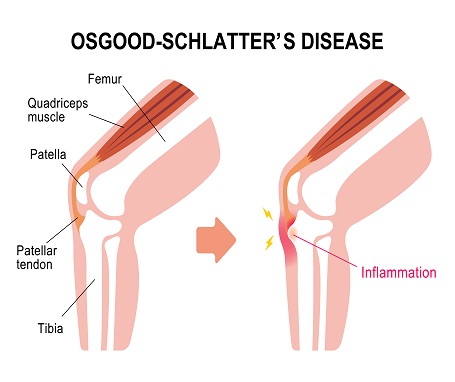Osgood Sch-latter Disease
Osgood-Schlatter disease isn’t as technical as it sounds. It is basically a common cause of knee pain in growing adolescents. It is an inflammation of the area just below the knee where the tendon from the kneecap attaches the shinbone. The disease generally occurs during a growth spurt in children which usually begins between the ages of 8-10 in girls and 10-12 in boys. By the time children reach the age of 15, bone growth is usually complete so the chance of them experiencing Osgood-Schlatter disease is highly unlikely. But is having Osgood-Schlatter disease a problem of concern for your child? How does it affect the growth of your child? These are the questions we will look into in this blog along with some more queries relating o the disease.
How does Osgood-Schlatter disease occur?
While indulging in activities such as running, jumping and playing sports like soccer, basket, football, etc, the muscles of the thighs pull on the tendon that connects the kneecap to the growth plate at the top part of the shinbone. Repeated stress on the thigh muscles can, in turn, cause the tendon to pull on the growth plate which can cause pain and swelling. In some children, the body tries to close the gap with a new bone growth which results in the formation of a bony lump at that spot.
How do I know if my child has Osgood-Schlatter Disease?
Usually, the condition prevails in one knee but it can happen in both knees. The main indicators of Osgood-Schlatter Disease are knee pain and swelling just below the kneecap. Other than that, the child may experience tightening of the thigh muscles and tenderness at the knee. It is advised to not give way to physical activities for a while till the pain and swelling reduces as it may cause more tension in the growth plate, thereby worsening the condition.
Can Osgood-Schlatter Disease be treated?
The goal of the treatment of Osgood-Schlatter Disease is to reduce inflammation and pain. If our child has very mild pain and swelling, rest and a hot and cold treatment can give relief. Hot and cold treatment basically involves using an ice pack or a towel wrapped around some ice cubes on the affected area to reduce swelling. Moreover, you can also use a hot pack to reduce swelling. Make sure you don’t use ice cubes directly on your child’s skin as it can cause ice burns. It should be taken into consideration that your child rests properly no matter how mild or extreme the pain is. During this time, limit physical activities. Your child can continue them once the pain vanishes.
Your doctor may recommend some stretching exercises for your child to loosen the thigh muscles and relieve pain. He/she may also recommend some drugs if nothing else works.
It should be ingrained in one’s mind as a parent that this disease is not as scary as it sounds. So, make sure you deal with it calmly and not put too much pressure on your child. Also, one should be aware of the fact that this disease may reoccur during your child’s growth spurts but that doesn’t make it scarier. Once your child is grown fully, the chances of reoccurrence of this disease are very slight. If you wish to get more information about this disease and its treatment, you can visit Vardaan Hospital, Delhi or contact us via email or phone. Our orthopedics are some of the greatest doctors in their field of study and they’ll guide you in a highly informative direction.

